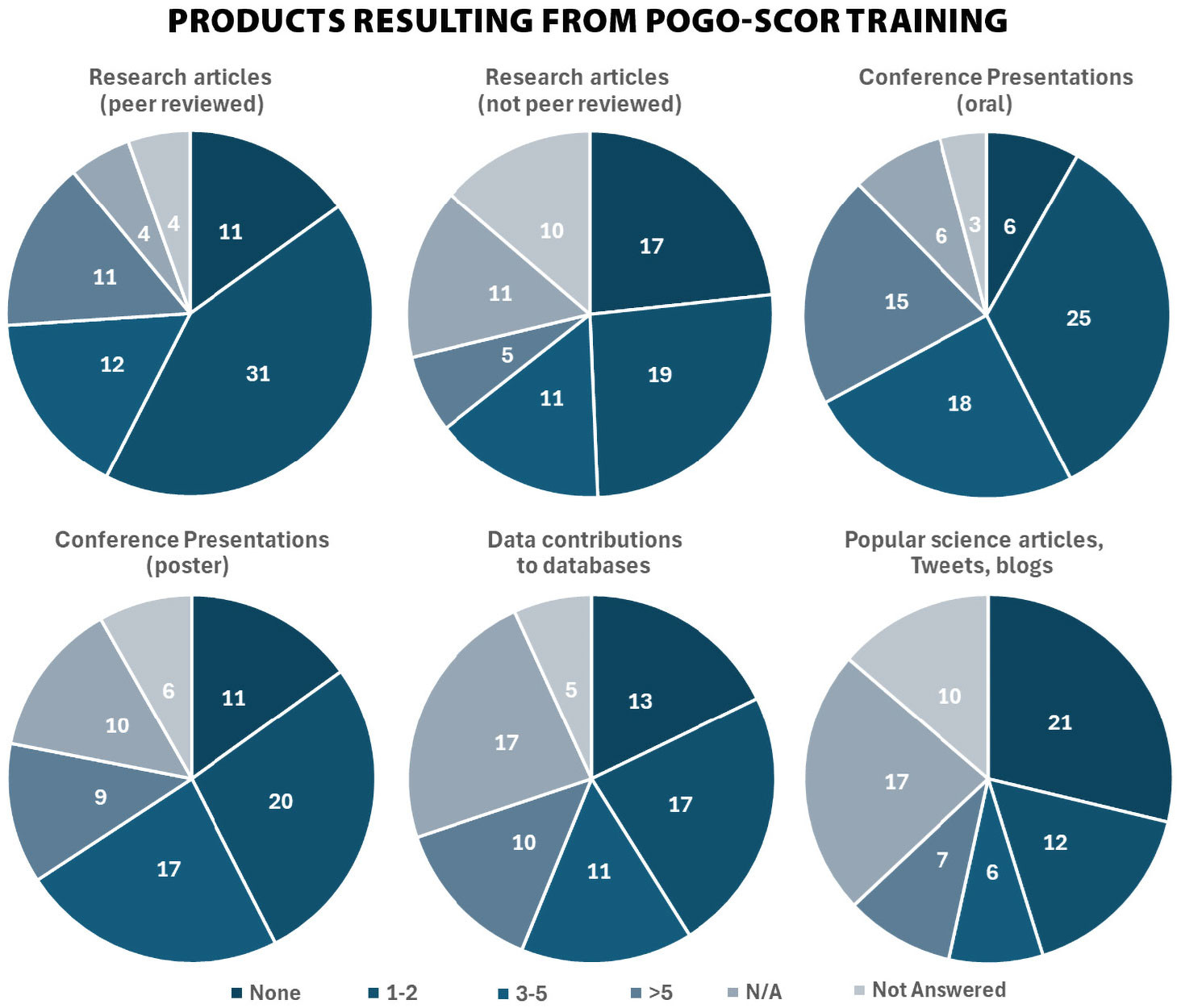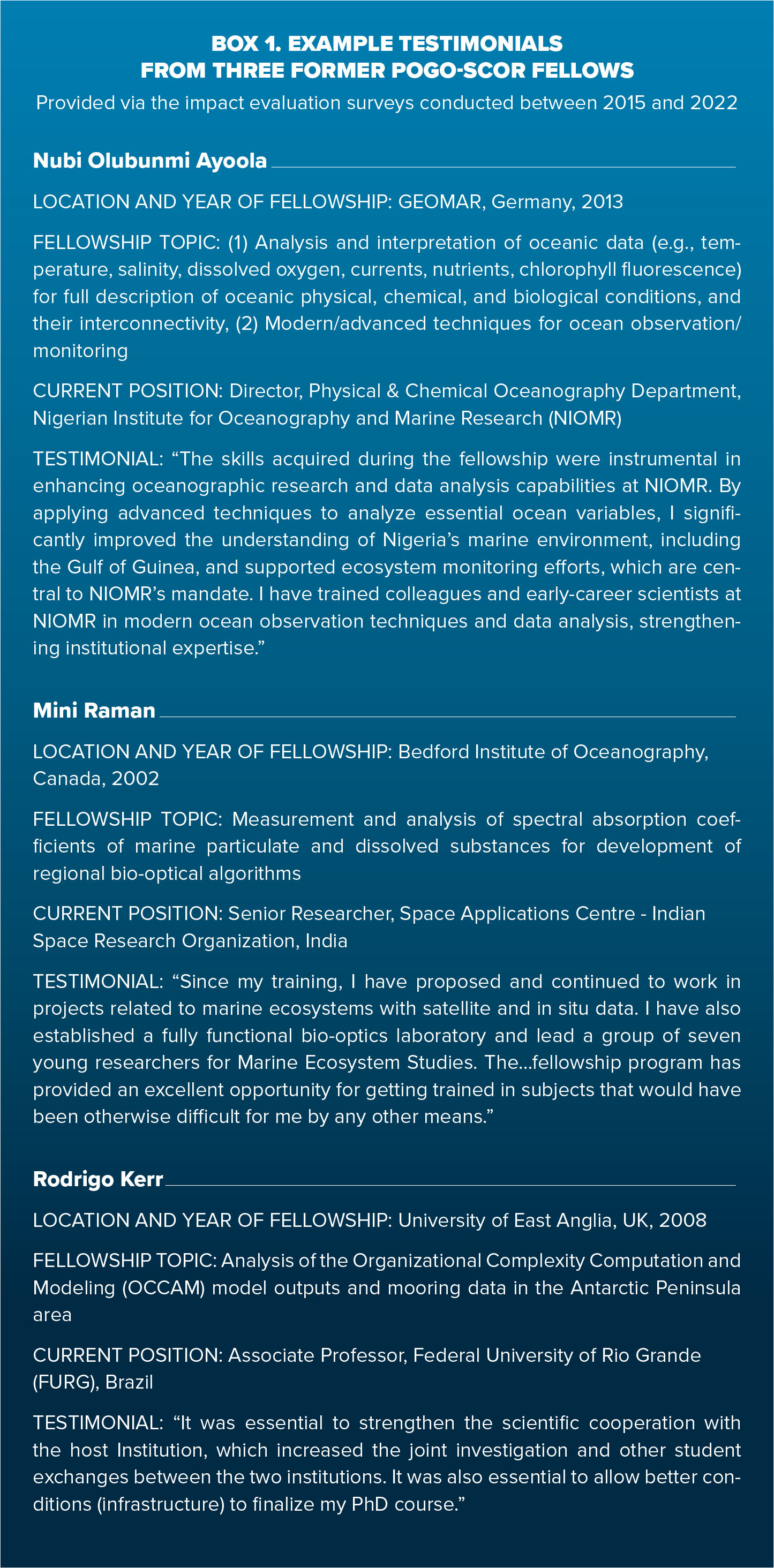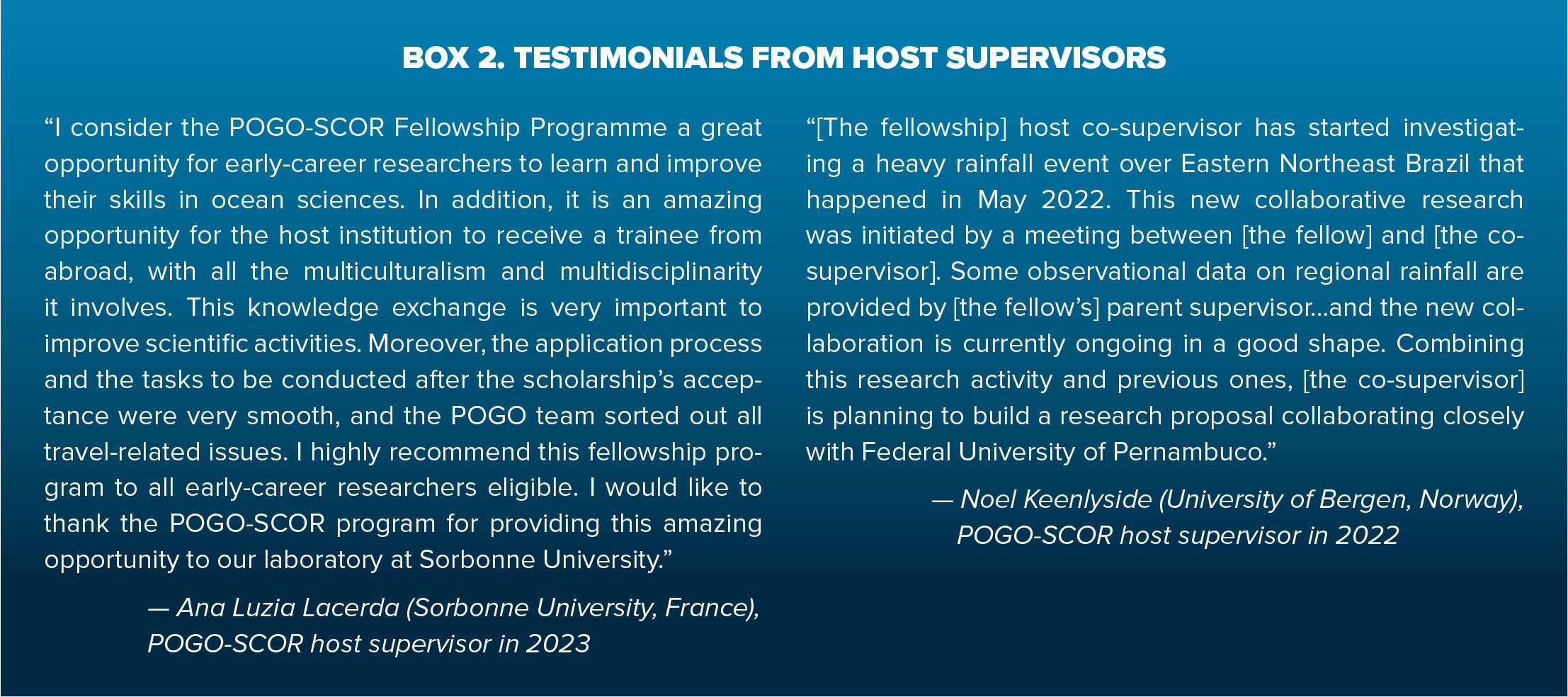Introduction: Why a Visiting Fellowship Program?
Providing grants for visits and exchanges of graduate students and postdoctoral scholars to or between research and higher education institutions in different countries has been a popular mechanism for capacity development since the early twentieth century. Many of these programs have been nationally funded and thus are reserved for visits of international students and postdoctoral fellows to a particular country, or conversely, for those from a particular country to travel abroad (e.g., German Academic Exchange Service [DAAD], US Fulbright Program, European Commission “mobility” schemes, and the European Union’s Erasmus and Marie Skłodowska-Curie Actions programs). While these programs generally allow for the completion of a postgraduate term or postdoctoral fellowship, they do not fulfill the need for shorter-term training in a specific topic, method, or technique.
To address this gap in the field of ocean science and observations, the Partnership for Observation of the Global Ocean (POGO), the Scientific Committee on Oceanic Research (SCOR), and the Intergovernmental Oceanographic Commission (IOC) of UNESCO came together in 2001 to develop a visiting fellowship program in ocean observations. The program continues to this day as a collaboration between POGO and SCOR (hereafter referred to as POGO-SCOR fellowships; https://pogo-ocean.org/capacity-development/pogo-scor-fellowship-programme/), with 200 fellows trained to date from 37 countries, and hosted by 21 different countries. A similar visiting fellowship program was put in place by the International Ocean Colour Coordinating Group (IOCCG) in 2002. The IOCCG program has now transformed into the IOCCG Platt Scholarship (https://ioccg.org/what-we-do/training-and-education/platt-scholarship/). POGO has also developed other models of fellowship (longer-term, ship-based), together with other partners, and funded mainly by the Nippon Foundation (Miloslavich et al., 2018; Krieger et al., 2025, in this issue; Krug et al., 2025, in this issue). Short-term visiting fellowships that are now a widely used mechanism for developing skills and capacities in both developed and developing countries can very effectively complement the reverse model of facilitating visits of more senior researchers to developing countries for teaching, mentoring, and research collaborations (Urban and Seeyave, 2021).
Visiting fellowships provide valuable opportunities for young scientists to visit other research institutions where they can access expertise and facilities that may not exist at their home institutions. Such visits are also important for broadening their research perspectives and exposing them to new ideas and challenges. For young scientists from developing countries, these fellowships may offer their first opportunities to travel abroad or outside their regions, which has both educational and cultural benefits. Such fellowships do not have to take place in a “South-North” direction—they can, and should, also facilitate “South-South” training and collaboration, as well as “North-South” visits for true “capacity sharing” to occur.
Grants for the one- to three-month POGO-SCOR fellowships include funding for international travel, domestic travel in the host country, and a monthly stipend based on the cost of living in the city being visited and the cost of accommodation. From a pool of around 40–50 applicants each year, five to six are selected based on the following criteria: quality of applicant, quality of proposal, adequacy of host institute/supervisor, relevance to POGO-SCOR and priority areas identified in the call for proposals, and potential for sustained capacity development in the parent institute and country.
POGO-SCOR fellowships are designed to provide one-to-one training and supervision, whereby the fellow is paired with a specific supervisor/mentor who provides professional training, guidance, and supervision throughout the fellowship period. In many cases, the fellowship takes the form of a mini research project, which may develop further into a thesis chapter and/or a publication in a peer-reviewed journal.
Finally, visiting fellowships have the potential for trainees (and trainers) to develop their networks of collaborators and to undertake follow-up activities and longer-term collaborations.
To assess the effectiveness of the POGO-SCOR fellowship program at providing all the opportunities and benefits listed above, training impacts are formally evaluated through surveys, fellowship reports, and more generally by staying in touch with alumni and keeping informed of their progress. The results from the evaluation surveys are presented in this paper, complemented by some testimonials and tangible evidence of impacts, followed by some lessons learned and recommendations for others wishing to establish similar fellowship schemes.
Results: The Impacts of POGO-SCOR Fellowships
In 2015, POGO and SCOR developed a questionnaire that was sent to all former fellows who were at least five years beyond the training. The questionnaire was carefully developed to extract the most useful information while making the survey “attractive.” A focus group of former trainees was consulted to develop a survey that they would feel motivated to answer. The survey consisted of background/demographic questions followed by several questions designed to evaluate the impacts of the training.
The survey received a total of 73 individual responses from fellows trained between 2001 and 2018, representing 43.7% of the POGO-SCOR fellowships during this period.
Demographics
- Gender. 66% of respondents identified as male and 34% as female (Figure 1), which resembles the gender distribution across all POGO training programs.
- Geography. The surveys were answered by past scholars from 20 countries in Asia (52%), Latin America (32%), Africa (8%), and Europe (8%).
- Age. 68% of respondents were between 26 and 35 years old during the training.
- Education and Professional Stage. 51% had master’s degrees and 79% were either students or researchers during the training period (Figure 1).
- Position at the Time of Survey. 36% were junior or senior researchers, 26% were lecturers or professors (assistant or associate), and 4% held director positions; 8% were undertaking postdoctoral studies.
- Time Spent Abroad. We found that around half of respondents had remained in their home country the entire time since the training. Of those who had spent some time abroad, only 30% were still abroad at the time of the survey. For those who were currently or had spent time studying/working abroad, the number of years spent in a foreign country varied, but the majority (64%) spent five years or fewer abroad. For those who were still abroad when answering the survey, 47% indicated that they intended to return home in the future.
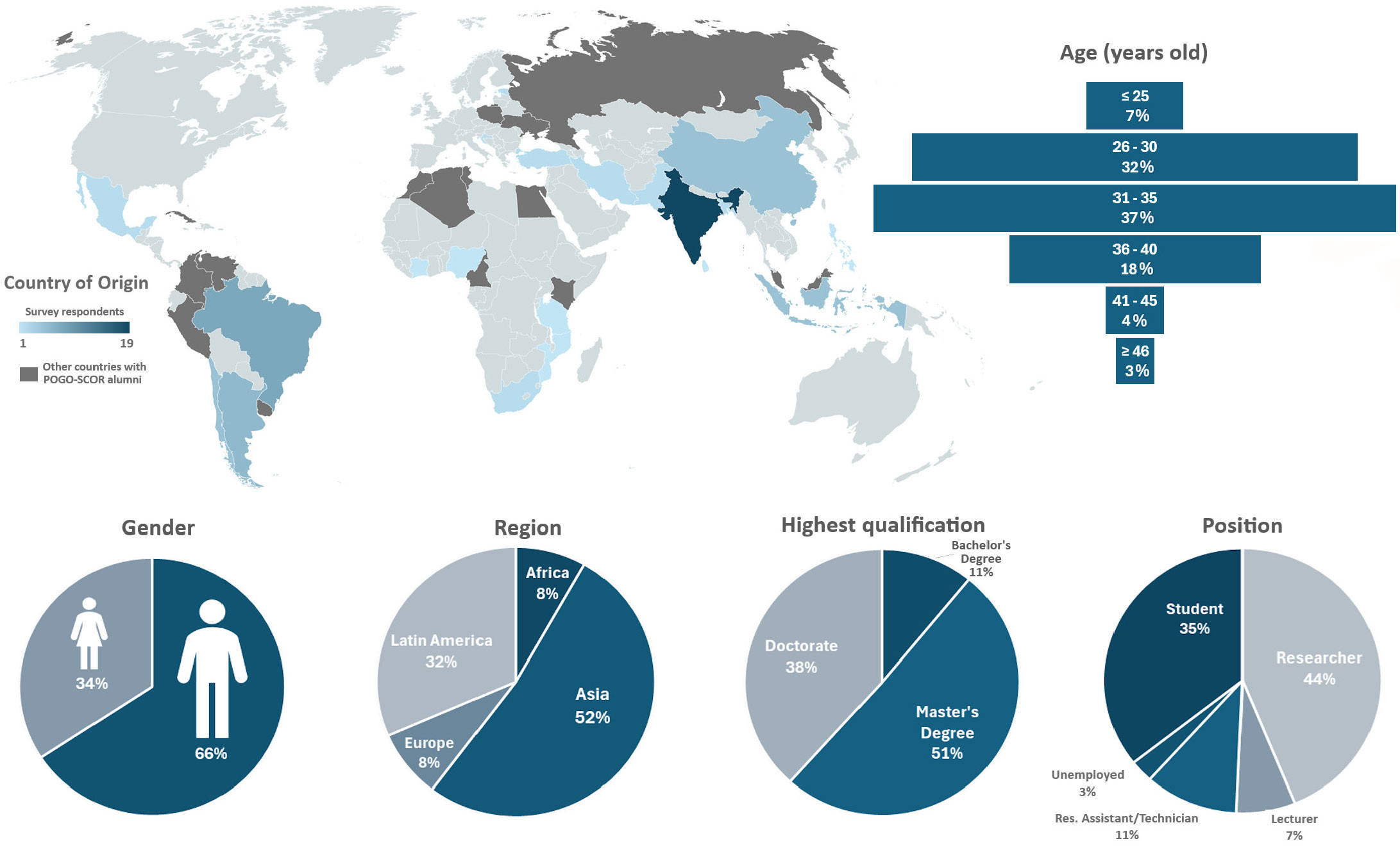
FIGURE 1. Demographics at time of training for POGO-SCOR alumni who answered the survey (n = 73). > High res figure
|
Impacts of Training
Trainees were asked how the training impacted their education, job prospects, and networking and collaboration opportunities (Figure 2). Respondents indicated that the fellowship was relevant to all aspects but particularly enhanced their ability to participate in new research projects, implement new techniques, and use new equipment and/or new software/models that were previously unavailable at the parent institute. Overall, most trainees reported continued collaboration with scientists they met during the training. Although we did not ask the respondents to elaborate on the techniques or equipment they had learned to use, we could infer from the fellowship topics that many of them focused on (1) analysis and interpretation of remote-sensing data; (2) deployment of autonomous platforms and other instrumentation (e.g., CTD, ADCP, radiometer); (3) laboratory analytical skills and/or taxonomy; (4) modeling; (5) establishing, maintaining, and analyzing data from time-series stations; and (6) data management, quality control, and processing of large datasets.
According to respondents, the training had some relevance in terms of securing more fulfilling and permanent positions, particularly in academia and management roles (Figure 2). For those who reported little impact on their professional positions, this may be explained by comments that they were already in their current positions while undertaking the training, while a few cited the lack of job opportunities in their home countries.
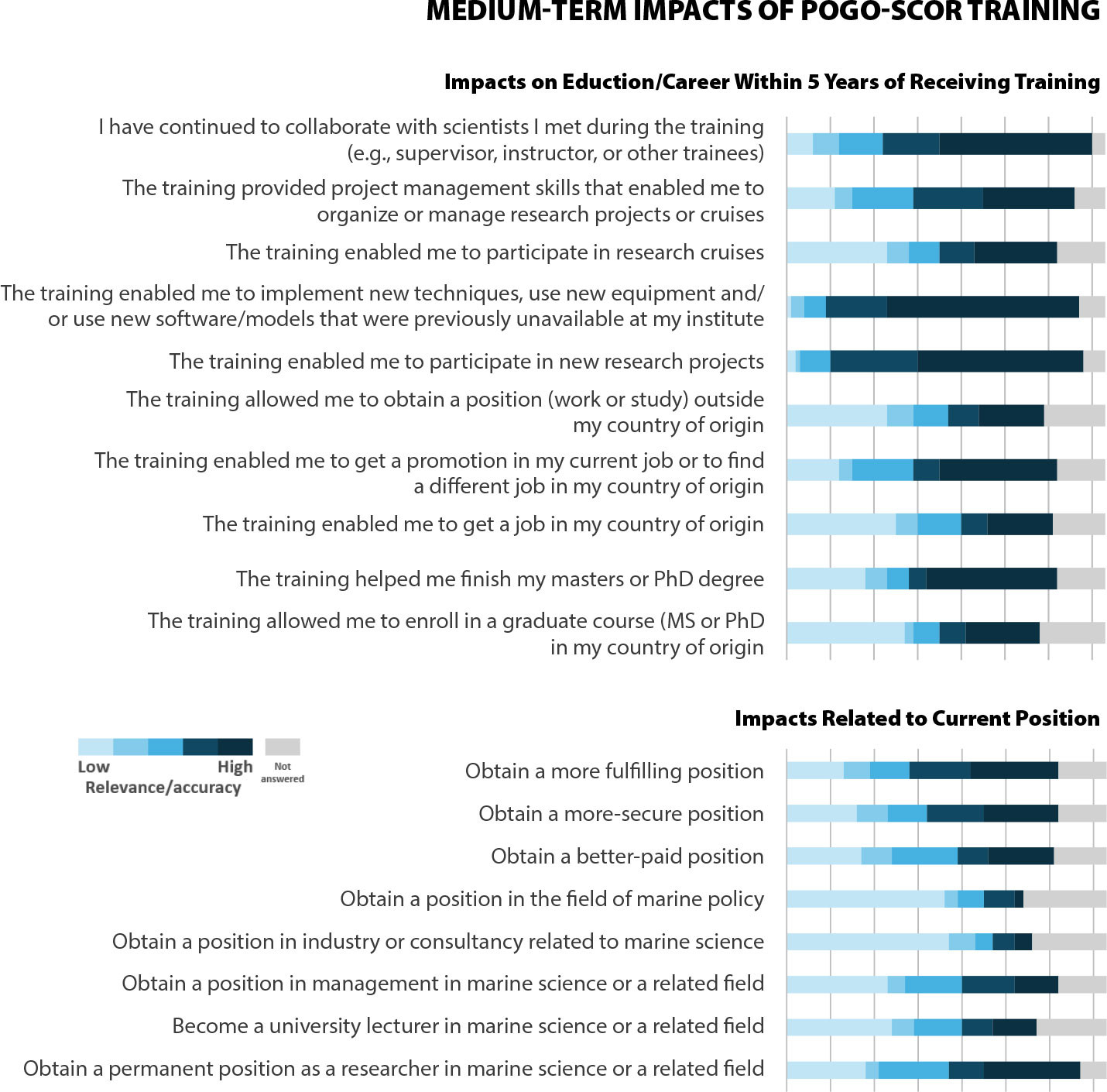
FIGURE 2. Survey responses regarding the medium-term impacts of the fellowships on their education and careers. > High res figure
|
Regarding the capacity sharing impacts on the trainee’s home institute, 82% of respondents stated that they had passed on the knowledge acquired during the training to their students, while 85% indicated that they had passed on the knowledge gained to their colleagues. Forty-two percent had supervised one to five undergraduates or graduate students and 62% had supervised or mentored one to five colleagues (e.g., research assistants, postdocs, researchers). Forty-eight percent of the trainees gave between one and five seminars or lectures based on the knowledge acquired during the training, with audiences ranging from >10 to >100 participants. In addition, four of the survey respondents indicated that one or more of their students had subsequently attended POGO training themselves.
The most common form of product based on the training was peer-reviewed publication (one to two research articles), followed by oral presentations at conferences and science communication via popular science articles and social media (Figure 3).
Benefits to Host Institutions and Continued Collaborations
In addition to the surveys, the POGO-SCOR fellowships require reports to be submitted by the fellows, the host supervisors, and the parent supervisors (at the fellows’ home institutes). These reports include summaries of the training and work accomplished during the fellowship, planned applications at the parent institution, comments by the supervisor on the trainee’s performance, and likelihood of the exchange leading to future collaboration. Both trainee and supervisor are also invited to provide general comments on the training program.
Although we cannot provide quantitative data for this, the comments from fellows and supervisors are always very positive (see examples in Boxes 1 and 2)—reflecting the benefits to both trainee and host supervisor in terms of their scientific research, exposure to another culture, and general broadening of their international collaborative networks. Opportunities for future collaboration are often mentioned as a possibility, and we are aware of several instances where the supervisor has subsequently visited the fellow’s parent institution for further cooperative work and/or to provide training (J. Sprintall, Scripps Institution of Oceanography, pers. comm., 2025). We are also aware of joint publications that have resulted from the POGO-SCOR fellowships: 27 citations in the Web of Science acknowledge POGO-SCOR as a source of funding (e.g., López Abbate et al., 2016).
Finally, several POGO-SCOR fellows have become integral parts of the POGO and SCOR communities by participating in those networks and organizing regional training courses themselves, sometimes with funding awarded by POGO or SCOR.
Conclusions, Lessons Learned, and Recommendations
The combination of numerical results from questionnaires and written reports from fellows and supervisors was an effective method for evaluating the long-term impacts of the POGO-SCOR fellowship program. The key findings were:
- The fellowships have had positive impacts on the fellows themselves. They enable fellows to participate in new research projects, implement new techniques, learn to use new equipment and/or software/models that were previously unavailable at the parent institute, and maintain collaboration with scientists they met during the training.
- The programs were also successful in “training the trainers,” with most fellows indicating that they had passed on the knowledge gained through seminars/lectures, student supervision, and/or mentoring/supervision of colleagues. This “multiplier effect,” whereby the training provided to one person reaches tens or even hundreds of people when the knowledge is passed on to colleagues and students, is a significant program legacy.
- Although the fellowships promote mobility (e.g., compared to visiting professor-type programs; see Urban and Seeyave, 2021) by providing connections to scientists/institutions in developed countries and by enhancing the eligibility of the trainees for further study or employment abroad, the program did not lead to a significant “brain drain” of early-career scientists away from their home countries.
- Formal and informal reports and communications indicate benefits to the host supervisor and institution and a strong willingness to continue the collaboration, evidenced in several cases by reciprocal exchange visits, joint publications, and joint projects. It is important to stay in touch with former fellows and supervisors in order to assess these longer-term impacts, and this can be achieved through formal alumni networks (such as the NF-POGO Alumni Network for the Ocean, NANO; see Krug et al., 2021), less formal social media groups/forums, and/or simply via occasional e-mail contact or meeting at international events.
- More widespread impacts are evident, where fellows have become key players in the international scientific community (POGO, SCOR, and beyond).
We encourage all international or regional organizations, funders, research institutions, and individual scientists to engage with existing visiting fellowship schemes or initiate new ones. Based on our experience over the last 25 years, we recommend that any organization looking to initiate a similar fellowship scheme consider the following:
- Requiring applicants to find their own host supervisor and write a fellowship proposal means they have to show initiative and a certain level of research independence.
- Having a robust and transparent set of evaluation criteria by which to rank applications will ensure that the best candidates are selected, and that the selection process is fair and can be justified.
- Conducting online interviews that include both the applicant and the prospective supervisor will allow you to assess not only the suitability of the candidate but also that of the proposed host, and the compatibility between the two.
- It is important to devise a logical and fair method for calculating stipends appropriate to the host country (e.g., based on a Cost of Living Index).
- Supporting the fellows from the point of selection to the final reporting requires time and dedication; in addition to the financial costs of the grants, careful consideration should be given to allocating the resources needed to manage and administer the program.
Such fellowships are more than just training or capacity development; they lay the foundations for successful and equitable international partnerships for solving the planetary crisis we—and the ocean—are currently facing.
Acknowledgments
The POGO-SCOR fellowship program is funded jointly by POGO (through membership dues) and SCOR (NSF OCE-2027831 and OCE-2346864) and administered by the POGO Secretariat. The authors wish to acknowledge L. Ruffoni and K. Iwaniak (POGO) for supporting the program’s coordination and administration. We thank all POGO-SCOR fellows who responded to the evaluation surveys, including O.A. Nubi, M. Raman, R. Kerr, A.L. de Figueiredo Lacerda, and N. Keenlyside for their testimonials. Special thanks to all the host supervisors who have welcomed fellows into their labs, dedicated their time to providing training, and made them feel at home. We dedicate this article to the memory of Trevor Platt, who contributed to the establishment of this program and hosted numerous POGO-SCOR fellows over the years.




